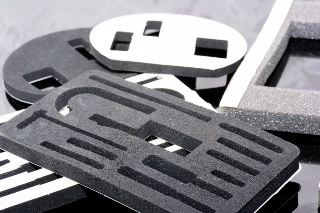Home » Technical » Additional Materials » Sponge
Sponge
Sponge Rubber Materials
Elastomers, including EPDM, neoprene, silicone and urethane, are also available in an expanded sponge form. Sponge offers the same flexibility with good compression as elastomers, but with additional properties.
 Sponge rubber is essentially made up of the same raw materials as most elastomers including a base polymer, additives, fillers, and plasticizers. To create sponge, polymers in the rubber compounds are mixed with a blowing agent to create pockets of air. These expanded polymers consist of cells in a matrix that are either open to each other or closed off from one another, creating open cell sponge and closed cell sponge materials. These cells are responsible for the properties of sponge. Sponge serves as a good barrier against gases and liquids, and is available in a variety of densities.
Sponge rubber is essentially made up of the same raw materials as most elastomers including a base polymer, additives, fillers, and plasticizers. To create sponge, polymers in the rubber compounds are mixed with a blowing agent to create pockets of air. These expanded polymers consist of cells in a matrix that are either open to each other or closed off from one another, creating open cell sponge and closed cell sponge materials. These cells are responsible for the properties of sponge. Sponge serves as a good barrier against gases and liquids, and is available in a variety of densities.
Web Seal can recommend the best sponge material for your specific sealing application.
Open Cell Sponge
Open cell sponge is a network of elastic rubber tunnels that readily allows air, water, and other media to pass through. Sponge is considered “open cell” when it is manufactured with at least half of its cells interconnected.
Because air is quickly expelled from these pockets when compressed, open cell sponge has excellent compression set. Unlike closed cell materials, open cell sponge has excellent resilience, with air quickly re-inflating the pockets and promptly returning the material to its normal dimensions when compression is removed.
Open cell sponge maintains good flexibility in low temperature ranges, and readily conforms to a variety of sealing applications. Many varieties exhibit good resistance to acids, bases, oils and other chemicals. Open cell sponge has good absorbency and surface adhesion. An example is EPDM-based sponge, which is very soft and has excellent resistance to aging, ozone, ultraviolet light and other weathering conditions.
Closed Cell Sponge
Closed cell sponge is more durable than open cell sponge. While manufactured with pockets as open cell sponge is, this type of sponge has balloon-shaped cells filled with nitrogen gas that are isolated from each other by membrane walls. When compressed, the gas in the cells squeezes through thin cell membranes. Depending on the base elastomer, closed cell sponges have varying rates of rebound when pressure is released, since the air more slowly re-inflates the individual cells.
This closed cell configuration resists fluids and gases into the matrix, making it ideal for multiple sealing applications. Closed cell sponge retains flexibility at low temperatures and offers robust sealing and weatherproofing. Most varieties are resistant to chemicals, oil, and weather. An example is closed cell Viton® sponge, which is manufactured with continuous skin on both sides, making it a stronger and more tear resistant sponge that performs well in temperatures from -10°F to 400°F (-23°C to 204°C).
Silicone Sponge Rubber
![]() Closed cell silicone sponge combines the durability of rubber with the lightness of foam. Similar in structure to closed cell sponge, silicone sponge rubber is manufactured by heat curing a gum-based polymer that expands the material but is softer and more yielding than standard silicone. Silicone sponge resists moisture, offers superior performance in extreme temperatures, harsh environments, and vibration dampening. Its exceptional compression set makes it ideal for industrial sealing applications.
Closed cell silicone sponge combines the durability of rubber with the lightness of foam. Similar in structure to closed cell sponge, silicone sponge rubber is manufactured by heat curing a gum-based polymer that expands the material but is softer and more yielding than standard silicone. Silicone sponge resists moisture, offers superior performance in extreme temperatures, harsh environments, and vibration dampening. Its exceptional compression set makes it ideal for industrial sealing applications.
Common Applications for Sponge Materials
Sponge is a versatile material used in many industrial and commercial applications.
- Air filters
- Antenna gaskets
- Appliance seals
- Automotive components
- Dirt and dust seals
- Gap fillers
- HVAC seals
- Industrial cushioning and padding
- Insulating and thermal barriers
- Marine equipment
- Mounting and non-skid pads
- Noise absorption and vibration dampeners
- Oil seals
- UL-rated lighting and electrical gaskets
- Wiring harness gaskets

